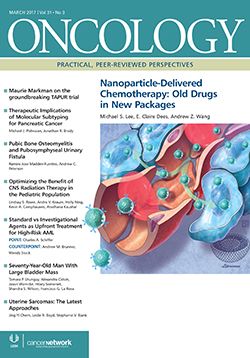POINT: Standard vs Investigational Agents as Upfront Treatment for High-Risk AML
Oncology (Williston Park). 31(3):190-191.

Charles A. Schiffer, MD

‘7+3’ Still Remains the Best Option for Most Patients
Acute myeloid leukemia (AML) is a heterogeneous disorder, with subgroups best classified by discrete mutations detectable by cytogenetic or molecular genetic techniques (the latter most informative in patients with normal karyotypes). For decades, the standard therapy has been initial treatment with cytarabine and an anthracycline, the so-called “7+3” regimen, followed by higher doses of cytarabine as consolidation. This approach is curative in ~40% of younger patients overall, with patients in some of the more favorable subgroups enjoying cure rates of ~60%. Many manipulations of this regimen, including dose intensification and the addition of other agents, have failed to improve on these results, suggesting an inherent mechanism of resistance to cytotoxic agents in some patients, who will likely require innovative, noncytotoxic strategies to improve outcomes. It is probable that some of the mechanisms of resistance are exaggerations of defenses against environmental toxins that allow normal hematopoietic stem cells and stem cells in other organs to survive. Interestingly, although countless in vitro studies have attempted to identify mechanisms of resistance, there is virtually no understanding of why certain subtypes of AML are sensitive to, and other subtypes develop resistance to, the same cytotoxic drugs.
That is the relatively good news. However, a significant fraction of patients either fail to achieve remission or relapse quickly and succumb to their AML. Although some can be salvaged with allogeneic stem cell transplantation in first or second remission, the relapse rate posttransplant is much higher in AML patients with genetic findings associated with resistance to chemotherapy, and even in those with minimal residual leukemia detected pretransplantation using very sensitive techniques.[1,2] In addition, the outcomes are worst in older patients, who represent the majority of individuals with AML, as well as in those whose AML either evolved from a prior diagnosis of myelodysplastic syndrome (MDS) or in whom the AML has morphologic or genetic features that resemble the features of MDS. In older patients, the long-term disease-free survival rate is at best 10% to 15%, and most are not candidates for transplantation.
Hence the sentiment to want to try totally new treatments instead of 7+3. This would certainly be appealing if promising therapies were available-and indeed, pharmaceutical companies have pounced on this “unmet medical need,” reasoning that it should be easy to improve on current outcomes in older patients. Not surprisingly, however, this has turned out not to be so easy; biologically resistant disease continues to be a tough egg to crack. A number of both phase II and randomized phase III trials have been conducted in older patients considered to be unsuitable for intensive chemotherapy, sometimes using straw men such as low-dose cytarabine or supportive care as controls, usually with overall survival as an endpoint.[3,4]
Apart from the difficulties in reproducibly defining the patient population to be targeted, these trials, many of which used putatively “gentler” therapy with hypomethylating agents and/or histone deacetylase inhibitors (so-called “epigenetic modifiers”), have demonstrated modest benefit, with few long-term responses.[4] Even for those who view the results of these trials more favorably than I do, the overall results are certainly disappointing, yielding little evidence that the agents studied provide cogent clues to future solutions for these patients.
Further complicating the interpretation of these trials and their impact on patient management, AML in older, higher-risk patients comes in two general “flavors”: a disease with lower blast counts that more resembles advanced MDS, or a true proliferative leukemia with hypercellular marrows and high blast counts. The latter often requires immediate intensive chemotherapy, and as a result, such patients have been infrequently enrolled in the trials mentioned previously. Advances in supportive care have permitted 7+3–like approaches in most older patients, with a 1-month mortality rate of < 10%[5]; 7+3 should thus be the initial consideration for all such patients.[6,7] Although complete remission rates with 7+3 vary from 30% to 50%, with median durations of remission of 6 to 12 months, in part depending on patient selection, patients clearly benefit clinically from complete remission-and even from a partial remission, with incomplete count recovery-and they should be afforded this opportunity.
That said, I am certainly supportive of testing investigational agents in all AML patients, particularly if there are encouraging data from studies in patients with more advanced disease, or with approaches that target specific driver mutations. There are few such “druggable” candidates at this time, although oral inhibitors of mutated FLT3,[8] and particularly of mutated IDH1 and IDH2,[9] qualify as sufficiently promising. It is already clear, however, that these agents will have to be added to chemotherapy to achieve maximal benefit. In the absence of such agents or of thoughtful clinical trials powered to detect important improvements in outcome, patients should not be denied therapy that has been proven to be of clinical value, albeit not often curative.
Financial Disclosure:The author has no significant financial interest in or other relationship with the manufacturer of any product or provider of any service mentioned in this article.
References:
1. Chen X, Xie H, Wood BL, et al. Relation of clinical response and minimal residual disease and their prognostic impact on outcome in acute myeloid leukemia. J Clin Oncol. 2015;33:1258-64.
2. Brunet S, Labopin M, Esteve J, et al. Impact of FLT3 internal tandem duplication on the outcome of related and unrelated hematopoietic transplantation for adult acute myeloid leukemia in first remission: a retrospective analysis. J Clin Oncol. 2012;30:735-41.
3. Sekeres MA, Steensma DP. Boulevard of broken dreams: drug approval for older adults with acute myeloid leukemia. J Clin Oncol. 2012;30:4061-3.
4. Kantarjian HM, Thomas XG, Dmoszynska A, et al. Multicenter, randomized, open-label, phase III trial of decitabine versus patient choice, with physician advice, of either supportive care or low-dose cytarabine for the treatment of older patients with newly diagnosed acute myeloid leukemia. J Clin Oncol. 2012;30:2670-7.
5. Löwenberg B, Ossenkoppele GJ, van Putten W, et al. High-dose daunorubicin in older patients with acute myeloid leukemia. N Engl J Med. 2009;361:1235-48.
6. Yang J, Schiffer CA. The artful management of older patients with acute myeloid leukemia. Expert Rev Hematol. 2016;9:425-32.
7. Schiffer CA. “I am older, not elderly,” said the patient with acute myeloid leukemia. J Clin Oncol. 2010;28:521-3.
8. Grunwald MR, Levis MJ. FLT3 tyrosine kinase inhibition as a paradigm for targeted drug development in acute myeloid leukemia. Semin Hematol. 2015;52:193-9.
9. Stein EM. IDH2 inhibition in AML: finally progress? Best Pract Res Clin Haematol. 2015;28:112-5.
